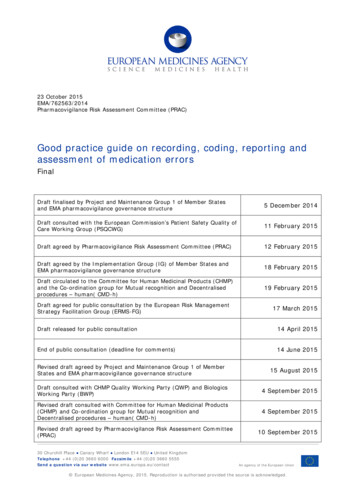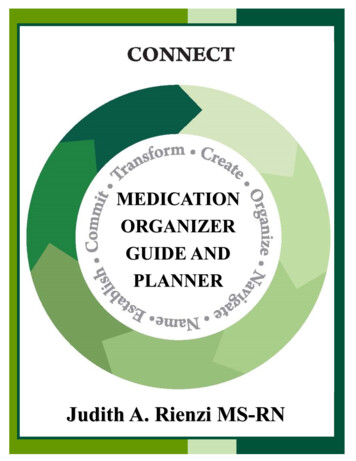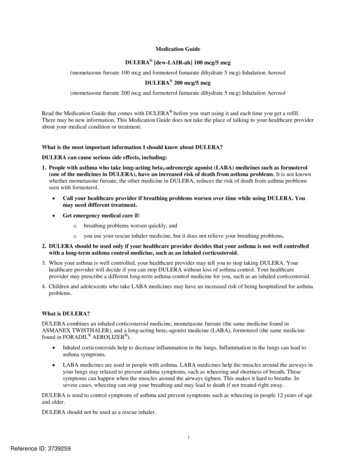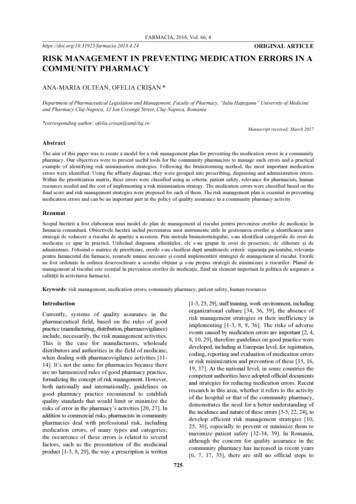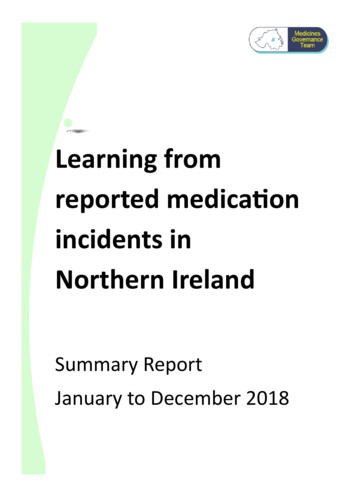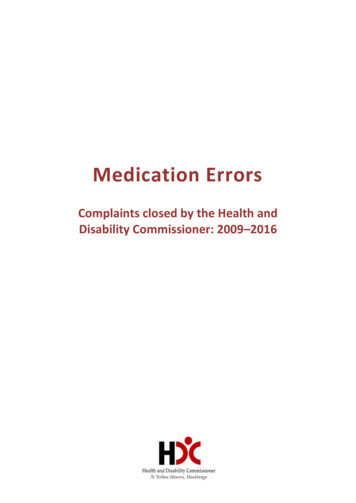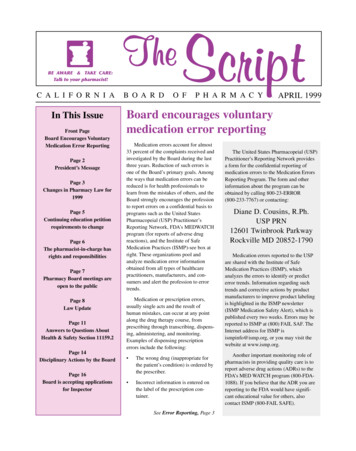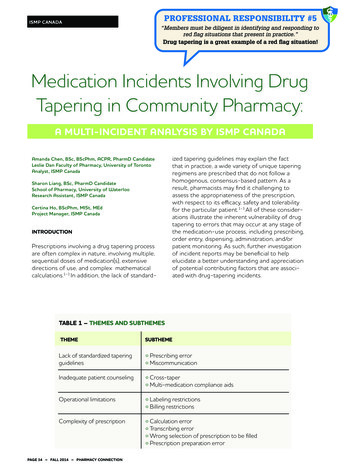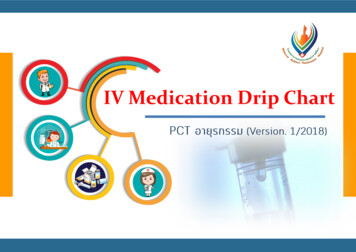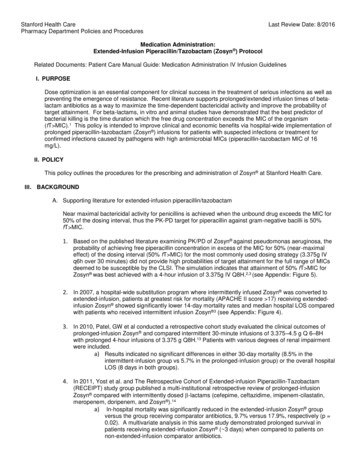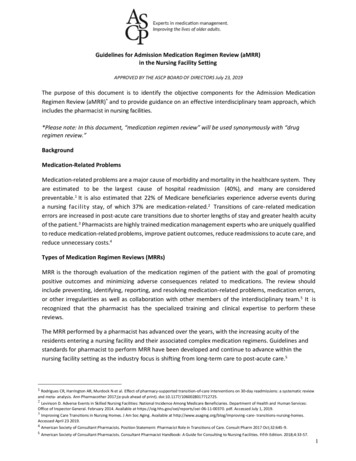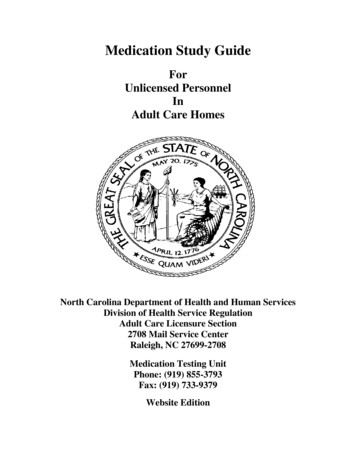
Transcription
Medication Study GuideForUnlicensed PersonnelInAdult Care HomesNorth Carolina Department of Health and Human ServicesDivision of Health Service RegulationAdult Care Licensure Section2708 Mail Service CenterRaleigh, NC 27699-2708Medication Testing UnitPhone: (919) 855-3793Fax: (919) 733-9379Website Edition
THE NORTH CAROLINA DEPARTMENT OF HEALTH ANDHUMAN SERVICES DOES NOT DISCRIMINATE ON THEBASIS OF RACE, COLOR, NATIONAL ORIGIN, SEX,RELIGION, AGE OR DISABILITY IN EMPLOYMENT OR THEPROVISIONS OF SERVICES.
TABLE OF CONTENTSPageIntroduction . iDefinitions iiiSection 1 – Study QuestionsAbbreviations/Medical Terminology Regulations .Medication Administration Measuring Devices .Metric System .Labels Medication Administration Records .Attachment A – MAR . Infection Control .138171920222425Section 2 – Answers to Study Guide Questions 27Section 3 – AttachmentsAttachment B Attachment C Attachment D Attachment E 48495051
Introduction to the Medication Study GuideAdministering medications is a very important task. Current regulations andrequirements for medication administration in adult care homes in North Carolinabecame effective January 1, 2000. One of the requirements is that any unlicensedperson administering medications or supervising the administration of medicationsmust pass a test given by the state of North Carolina. Information such asschedules and changes regarding medication testing may be found on our websiteat http://www.ncdhhs.gov/dhsr/acls/.The purpose of the Medication Study Guide is to help you become moreknowledgeable with administering medications and better prepared for the test.There are three sections to the Medication Study Guide.In Section 1, there are 118 questions divided into the following areas:1.2.3.4.5.6.7.8.Abbreviations/Medical TerminologyRegulationsMedication AdministrationMeasuring DevicesMetric SystemLabelsMedication Administration RecordsInfection ControlYou need to read each question thoroughly and choose the best answer.In Section 2, you will find the answers to each of the questions in Section 1.Except for questions 1 through 20, there is an explanation of why the answer iscorrect. The explanation should help you learn more about your important rolewith administering medications and better prepare you for the test. It is veryimportant that you understand why the answer is correct. If you need additionalhelp with questions, you should ask a pharmacist or nurse for assistance.Section 3 has additional attachments for you to use as resources. You should try toanswer the questions without using the attachments.This study guide was also developed as a training tool in addition to workshops ortraining programs on medication administration. It is not a substitute for attendingworkshops or training programs on medication administration. With the studyguide, you can go at your own pace and review any area of the questions as manyi
times as you wish. It can help you see if you need further training in one of theareas.There is an answer sheet in the study guide for you to use as you answer eachquestion. An answer sheet similar to the one in the study guide will be used for themedication test. You should choose the letter that corresponds to the best answerand fill in the circle under the letter that corresponds with the best answer.Disregard the “T” and “F” in the circles on the answer sheet. If you need help withusing the answer sheet, ask your supervisor, nurse or pharmacist for assistance.Remember, this study booklet is only a guide! The questions on the test will besimilar to the questions in this study guide. There will be questions on the testpertaining to each of the areas in the study guide. The medication test given by thestate will have approximately 60 questions.We all know that taking tests can be stressful. The medication administration testbeing given by the state will be on the basics of medication administration. Usingthis study guide in addition to attending workshops and programs on medicationadministration should help you not only be better prepared for the test but alsobecome more knowledgeable and skilled with administering medications.Becoming more competent in administering medications will help residents inadult care homes avoid serious medication-related problems.ii
DefinitionsKnowing the following terms will help you with the study guide.Administer: to give out, insert or apply medication to a person.Controlled Substance: Medications that have the potential to be addictive and used in away other than the medication was prescribed; a system must be in place to account forreceipt, administration and disposition of each medication.Dispense: Preparing and packaging a prescription medication in a container withinformation required by state and federal law; anytime more than one dose of medicationfrom a supply is placed in another container and labeled, it is considered dispensing.Dispensing Practitioner: A licensed health professional who has the authority to dispensemedications; a pharmacist is the dispensing practitioner you may be the most familiar with.Document: To record or write; Documentation of the administration of medications isrequired on the medication administration record (MAR).Label: Information on the medication package; referred to also as medication label orprescription label.Medication Administration Record (MAR): A record that lists all of the medicationsordered for the resident, including routine or regularly scheduled medications and PRNmedications; It is used to document or record the administration of medications.Medication / Drug: Another word used for drug; a substance or mixture of substancesused in the diagnosis, cure treatment or prevention of disease.Medication Pass: Scheduled time of the day when medications are administered toresidents.Non-controlled Medications: All other prescription medications that are not listed ascontrolled substances.OTC Medications: Over-the-counter or non-prescription medications; medications whichcan be purchased or obtained without a prescription; however, you need a physician’sorder to administer them.iii
Prescription Medications: Medications that can only be obtained or purchased through anorder or prescription written by a physician or prescribing practitioner.PRN – as needed or if necessary; PRN medications are not scheduled to be administered atspecific times.Prescribing Practitioner – Refers to a licensed health care professional who is authorizedto prescribe or order a medication; the prescribing practitioner people are the most familiarwith is a physician or doctor. Other prescribing practitioners include physician assistants,family nurse practitioners and dentists.Report: To make known, to give information about something.Side effects: Any effect other than the desired effect; unwanted effects or adversereactions from a medication.Transcribe: To transfer written information from one place to another; information onthe physician’s order must be transcribed to the medication administration record (MAR).Vital Signs: Measurement of a person’s heartbeat, blood pressure, breathing andtemperature.iv
SECTION 1STUDY GUIDE QUESTIONS
Abbreviations/Medical TerminologyMatch each term in Column 1 to its abbreviation in Column 2 by choosing the letterof the abbreviation for each term.1.2.3.4.5.6.7.8.9.10.Column 1: TermHour of sleep or bedtimeTwice a daySubcutaneousEvery other dayOnce a dayColumn 1: Termgrammilligramafter mealsOTCby mouthA.B.C.D.E.Column 2: Abbreviationqod or QODqd or QDbid or BIDsq. or SQHS or qhsA.B.C.D.E.Column 2: AbbreviationpcmgOver-the-CountergmpoMatch each abbreviation in Column 1 to its term in Column 2 by choosing the letterof the term for each abbreviation.Column 1:Abbreviation11.12.13.14.15.qacqid or QIDtspprn or PRN16.17.18.19.20.Column 1:AbbreviationTbsptid or TIDmlozMARColumn 2: TermA.B.C.D.E.A.B.C.D.E.1TeaspoonfulBefore mealsAs neededEveryFour times a dayColumn 2: TermThree times dailyMilliliterOunceTablespoonfulMedication administration record
21. The following are abbreviations for drug routes, EXCEPT:A.B.C.D.POIMPDSL22. You receive an order for Nitroglycerin to be given sublingually. It would be given:A.B.C.D.Under the tongueBy mouthInstilled in the earApplied to the skin23.The following are abbreviations for dosages or strengths of medications EXCEPT:A.B.C.D.mgmlgmPD24.If you are not sure of an abbreviation, it is O.K. to guessA. TrueB. False25.It is important to know the policy on approved abbreviations for your facility.A. TrueB. False26.A milliliter is the same as a milligram.A. TrueB. False2
Regulations27. Over-the-counter drugs may be kept as floor stock or house stock in an adult carehome.A. TrueB. False28. When administering medications, it is O.K. to leave a resident’s medication at thebedside if the resident is present.A. TrueB. False29. You are legally responsible for any medication or treatment you administer.A. TrueB. False30. Medications should be given within one hour before or one hour after the prescribed orscheduled time of administration.A. TrueB. False31. Residents have a right to refuse medications.A. TrueB. False32. Oral medications must be stored separately from topical or external medications.A. TrueB. False33. Staff giving medications in adult care homes have to demonstrate certain skills withadministering medications and be checked off or validated by a registered nurse orregistered pharmacist.A. TrueB. False3
34. Regulations for the accountability or recordkeeping of controlled substances differfrom the regulations for non-controlled medications.A. TrueB. False35. Unlicensed staff in adult care homes may administer intramuscular (IM) injections andsubcutaneous (SQ) injections.A. TrueB. False36. A telephone or verbal order for medications and treatments must be signed by theperson who prescribed the medications within:A.B.C.D.15 days from the date the order is given.30 days from the date the order is given.20 days from the date the order is given.None of the above37. Information or documentation on the MAR for PRN (as needed) medications that areadministered includes:A.B.C.D.E.the amount or quantity of medication administered.the specific time of administration.the initials of the person administering the medication.the effectiveness of the medication.all of the above.38. Mr. Jones, a resident of an adult care home, is going to visit his family for the week.The proper way to prepare Mr. Jones’ prescription medications to take with him wouldbe to:A. Remove the amount of medications needed for the week from the resident’s supplyof medication, place the medications in labeled containers and document themedications sent on the appropriate facility form.B. Send the medications in containers that have been filled and labeled by a pharmacistand document the medications sent on the appropriate facility form.4
39. The resident’s physician or prescribing practitioner is to be contacted about theresident’s medication orders:A.B.C.D.if the FL-2 is not dated and signed within 24 hours of admission to the facility.when the medication orders on a FL-2 and discharge summary do not match.if a medication order is incomplete or unclear.all of the above.40. The facility is required to maintain or keep all medication orders for a resident:A.B.C.D.in the resident’s record in the facility.at the pharmacy.in any type of notebook or record, as long as the order is in the facility.in the resident’s room.41. The following statement about non-prescription (OTC) medications is FALSE:A. They may be kept in the original container with the manufacturer’s label andexpiration date.B. They may be packaged and labeled by a pharmacist.C. They may be administered to a resident without a physician’s order.D. They can produce unwanted effects.42. Which of the following is TRUE when prepouring or preparing medications inadvance:A. Oral solid medications (tablets and capsules) for routine administration may beprepared within 24 hours of the prescribed time for administration.B. PRN medications may be prepared in advance.C. Medications may be crushed at the time the medications are prepoured or preparedin advance.D. A, B, and C are true.43. You have to document on MAR when a medication is:A.B.C.D.AdministeredRefusedOmittedAll of the above.5
44. In order for a medication to be administered you must have:A. permission from the familyB. a drug handout of information from the pharmacistC. a physician’s order45. “As needed” (PRN) medications must be administered according to:A.B.C.D.The facility’s administration time schedule for medications.The resident’s choice of time and frequency.The reason and frequency of administration specified in the physician’s order.The family’s request on how often the medication can be given and for whatreasons.46. When should medications be signed off on the MAR?A. After a resident has been observed to actually take the medicationB. After all the residents have been administered their medications and observed toactually take the medicationsC. After the medication label is checked with the MARD. Before the county or state visits the home.47. You remove a resident’s medications from the packages or containers and the residentrefuses to take his 12PM medications, you should:A. Put each medication back into the appropriate container or package that themedication came from.B. Leave the medications with the resident in case the resident decides to take themedications later.C. Dispose of the medications in accordance with the facility’s policy and procedures.D. Both A and C are correct.48. When medications are stored in a refrigerator that is accessible to residen
There is an answer sheet in the study guide for you to use as you answer each question. An answer sheet similar to the one in the study guide will be used for the medication test. You should choose the letter that corresponds to the best answer and fill in the circle under the
